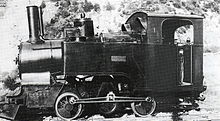Leuk-Leukerbad Railway
| Leuk – Leukerbad | |||||||||||||||||||||||||||||||||||||||||||||||||
|---|---|---|---|---|---|---|---|---|---|---|---|---|---|---|---|---|---|---|---|---|---|---|---|---|---|---|---|---|---|---|---|---|---|---|---|---|---|---|---|---|---|---|---|---|---|---|---|---|---|
| Route length: | 10.4 km | ||||||||||||||||||||||||||||||||||||||||||||||||
| Gauge : | 1000 mm ( meter gauge ) | ||||||||||||||||||||||||||||||||||||||||||||||||
| Power system : | 1500 V = | ||||||||||||||||||||||||||||||||||||||||||||||||
| Maximum slope : |
Adhesion 60 ‰ rack 160 ‰ |
||||||||||||||||||||||||||||||||||||||||||||||||
| Rack system : | Dept | ||||||||||||||||||||||||||||||||||||||||||||||||
|
|||||||||||||||||||||||||||||||||||||||||||||||||
The Leuk-Leukerbad-Bahn , abbreviated LLB , French Chemin de fer Loèche-Loèche-les-Bains , operated a 10.4 kilometer long, electrified and narrow-gauge rack railway in the Swiss canton of Valais between 1915 and 1967 .
history
In 1908 the Compagnie du Chemin de fer électrique de Loèche-les-Bains SA was founded, the purpose of which was to build and operate the narrow-gauge railway from Leuk to Leukerbad . Construction of the Leuk-Leukerbad Railway began on February 29, 1912. In order to save costs, the rails were laid over a length of 2.5 kilometers in the planum of the road to Leukerbad. On July 15, 1915, the service began.
The route of the Leuk-Leukerbad Railway branched off from the main Lausanne – Brig line . The starting point is located in the Rhone valley at an altitude of 623 meters above sea level and in the municipality of Leuker hamlet Susten . In order to distinguish the central station in Leuk ( French: Loèche ) from the state station, which is a little further away, the long-distance station was originally called Leuk SBB . The train station in the village of Leuk, however, was called Leuk Stadt .
From the starting point, the route led through the Dala valley via the slightly higher Leuk up to the health resort Leukerbad ( French: Loèche-les-Bains ) at an altitude of 1394 meters. In order to overcome the difference in altitude of 771 meters and the gradients of up to 160 per thousand, 5.1 kilometers of the route were provided with a rack from the Abt system.
In addition to the three larger stations Leuk SBB, Leuk Stadt and Leukerbad, there were other small intermediate stations. These were the Inden train station and the Albinen , Rumeling and Russengraben stops . The depot building and the workshop of the Leuk-Leukerbad-Bahn were located at the starting point Leuk SBB. At the end point of Leukerbad there was also a small remise .
In the first few years of operation, however, the trains only ran from Leuk Bahnhof to Leuk Stadt in winter. The last trip took place on May 27, 1967. After that, the railway line was shut down and most of it was dismantled. One of the reasons for the discontinuation was the alignment, which had led to obstructions to road traffic. In addition, replacing the aging vehicles with new rolling stock would have been too costly.
Today the LLB, the abbreviation stands for Verkehrsbetriebe Leuk-Leukerbad and the surrounding area , uses buses on the route to Leukerbad . The reception building of indene was preserved and is now used as the village shop.
vehicles


The three blue-gray electric railcars of the LLB of the type ABFe 4/4 with the numbers 10, 11 and 12 were supplied with 1500 volts direct current . There were also several passenger and freight cars available.
- Traction vehicles
- HG 2/2 1 (1914) Maschinenfabrik Esslingen according to plans of the SLM , 1935 conversion to snow plow X 1
- BCFeh 4/4 4/4 10 to 12 (1914) SWS / SIG / BBC, 10 handed over to the Blonay – Chamby museum railway in 1967, 11 and 12 canceled in 1967
The three railcars were built in 1914 by the SWS , SIG and BBC . The vehicles, which had a service weight of 33 tonnes, were 12.6 meters long over buffers and had a top speed of 30 km / h, could move two 255 hp engines each uphill. They offered eight seats in the former second and 24 seats in the former third carriage class . In the winters of 1944/1945 and 1945/1946, the railcars were fundamentally renewed in the workshops of SIG, SLM and BBC. Smaller and more powerful engines replaced the two original 170 hp drives.
- Passenger cars
- BC4 4/4 20 to 22 (1915) SWS, 20 handed over to the Champlan children's home near Sion , used there as a library, canceled in 1995; 21 canceled in 1967; To 22 in 1967 Blonay-Chamby issued
- Freight and company cars
- K 40 and 41 (1915) SWS, handed over to the Blonay – Chamby museum railway in 1967
- M 50 to 52 (1915) SWS, 50 canceled in 1967, 51 and 52 handed over to the Blonay – Chamby museum railway in 1967
- L 60 and 61 (1915) SWS, 60 and 61 handed over to the Blonay – Chamby museum railway
- X 1, converted into a snow plow in 1935 HG 2/2 1, broken off in 1967
There was also a small snow plow , known as a Sputnik , and a catenary assembly trolley. Both were canceled in 1967.
literature
- Florian Inäbnit: Leuk – Leukerbad electric rack railway. Buffer stop Druck & Verlag, Wengen 1995.
Web links
- Leuk - Leukerbad Bahn (LLB) In: discontinued-bahnen.ch by Jürg Ehrbar
- Information about the Leuk-Leukerbad-Bahn , on the official website of the successor company
- On the trail of the Leuk-Leukerbad-Bahn
- History of the Leuk-Leukerbad-Bahn at the Foundation for Transport History
- Swisstopo, time travel through maps from 1847 to today with the course of the railway line
Individual evidence
- ↑ The narrow track : Leuk-Leukerbad-Bahn , www.schmalspur-europa.at
- ↑ Brochure by Sébastien Jarne (ed.): Le chemin de fer touristique Blonay – Chamby. Lausanne 1986, LLB BCFeh 4/4 10

